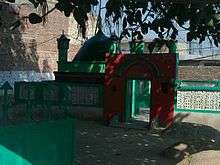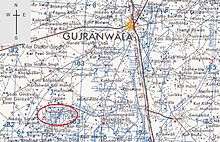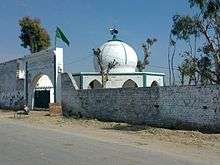Buddha Goraya
| Buddha Goraya بڈھاگورائیہ | |
|---|---|
| Village | |
 Buddha Goraya Location in Pakistan | |
| Coordinates: 32°2′26″N 74°3′25″E / 32.04056°N 74.05694°E | |
| Country |
|
| Region | Punjab |
| District | Gujranwala District |
| Union council | Itself |
| Government | |
| • Nazim | Vacant |
| • Naib nazim | Vacant |
| Area | |
| • Village | 5 km2 (2 sq mi) |
| Elevation | 228 m (750 ft) |
| Population (2008) | |
| • Village | 5,000 approx. |
| • Urban density | 200/km2 (500/sq mi) |
| • Rural | All |
| Time zone | PST (UTC+5) |
| • Summer (DST) | PST (UTC+6) |
| Postal Code | 52361 |
| Area code(s) | 055 |
Buddha Goraya / Budha Goraya / Budha Guraya / Urdu: بڈھاگورائیہ Hindi: बुढ्ढा गोराया is a developing village in Gujranwala District, Punjab, Pakistan.
Etymology
Buddha means old person while Goraya is a caste in Jatt clans. Originally this word was formed when some oldmen who were herders (by caste they were Goraya, Jat) used to graze their herds when this area was meadows in the past. Travelers took this as milestone and indicator of the right direction of their travel, further they started calling them Buddhay Gorayan De (oldmen of Goraya caste). Now this is shortened to Buddha Goraya. Erstwhile it was also called as Rammalli Gorayan Di which is also composite of Rah (passage) Malli (occupied) Gorayan Di (by the Gorayas), that makes the etymological development more authentic.
History


There is a Shrine of a Sufi Saint Pir Madha Shah Sultan which according to the stories was built around 1700. There is also PEER SALAM's shrine. There are some families which are living here since centuries.
There is Bhirr (mound of earth, remnants of settlement), that is said to be a village destroyed by earthquake, about 3 km south of Buddha Goraya. Now this is used as Play Ground as well Graveyard of two villages namely Dhair Virkan & Pipli Goraya.
Dhair Virkan https://www.google.com/maps/place/Dhair+Virkan (One of them Villages exist in Tehsil Nowshera Virkan with VIRK caste named 2.Chak Sadu Virkan, 3.Mangoki Virkan, 4.Matta Virkan, 5.Baloki Virkan, 6.Leel Virkan, 7.Melu Virkan, 8.Gharmula Virkan, 9.Duburji Virkan, 10.Wandala Virkan, 11.Udday Virkan, 12.Ratali Virkan, 13.Masanda Virkan, 14.Bharokey Virkan, 15.Chak Virkan, 16.Sahoke Virkan, 17.Chaleyki Virkan) and Pipli Goraya (Last Village of Goraya Caste) This destroyed village was the original village of the herders. After the destruction of the village the survived evacuees settled in the surroundings of this village in their possessed lands. These settlements are now called after their names like Lonkay City, Dhair Virkan(First Village of Virk Caste) Pipli Goraya, Saddu Goraya, Ratta Goraya, Chitti Goraya, Mahiya Goraya, Jajoki Goraya, Harchoki Goraya, Bupra Kalan Goraya, Bupra Khurd Goraya. They were said to be brothers or cousins and were Hindus but when Sikhism flourished they converted to it. Sikhism was founded in 15th century so it seems that this village has witnessed five centuries at least.
A village with same name is also there in Sialkot district near Daska, which was also settled by one (perhaps who got married in Sialkot and decided to move there) of the same herders in memory of his kins in this very Buddha Goraya.
Demographics
Its population is a blend of different religious sects and family clans. Majority is Muslim (Sunni 99.9% Shi'a 0.1%) whereas 5% of its total population is Christian, there is also a family of Ahmedis. Other demographics include Rajput mostly migrated from Talwandi Malak Patiala State India, Jat local, Butt originally from Kashmir before partition, Dogar local, Kumhar or Rehmani local & some migrated, Shaikh or Qasab local, Mochi or Bhatti, Nai or Barber, Khokhar, Julaha and some others. Mostly there's always harmony among all units but politically there are some clashes and tusils.
Geography and climate

Buddha Goraya is located at 32°2′26″N and 74°3′25″E (wikimapia). It is 228 m (750 ft) above the sea-level. It is 15 km from Gujranwala on recently built off-root of National Highway N-5 leading to Nowshera Virkan that is 12 km in south of Buddha Goraya.
Buddha Goraya enjoys all seasons of nature. It is on a plain with smooth surface and beautiful landscape. Monsoon waters flourish its crops. Its climate changes quite drastically through the year. The summer periods last from May through September where the temperature reaches 40–42 degree Celsius. The colder months are usually November to February. The temperature can drop to 5 degree Celsius on average. The highest precipitation months are usually July and August when the monsoon season hits the Punjab province. Whereas the other months the average rainfall is about 25 millimetres (0.98 in). The driest months are usually November through April where little rainfall is seen.
Economy
Being an agricultural area most of its economy consists of seasonal crops mainly wheat, rice (undoubtedly this area produces 1st grade rice in the world), potatoes, sunflower, watermelon, melon, peas and some other vegetables & fruits are at the top.
Along with the above employment is also one of the main source of income for its people. A good number of locals is working for Public and Private sectors.
Some other sources include the cottage industry that includes carpet weaving which are exported to foreign by the local agents who usually purchase these from the local workers. There are also some factories for elastic (for multipurpose use, especially in garments) knitting.
Additionally dairy farming is also one of the units of its economy. Although there is no dairy processing unit the dairy milk is sold in local market and in Gujranwala as well.
Culture


This village has pure Punjabi culture although its population belongs to different areas. All the migrants have adopted the local trends and life style. They have also made natives to change according to their trends a little. With changing trends of region there is also change in the life style. Traditional Dhoti Kurta and Pagri is now being replaced with Shalwar Qameez & pant shirt. But yet the old Punjab can be seen in the old men & women. Melas (fares) are now losing audience.
Education
The literacy rate of Buddha Goraya is very healthy. 60% of its population is literate and people want their children to be educated in good manners.Therefore, they send their children to city Gujranwala for education .People also think that there will be a college in their region so that their children can easily get education . It will also help them to save their money. A secondary level school for boys was built in 1967 while a primary level school was already there in 1947, Seat of Principal of BPS.19 is still vacant since 2014. 10 Secondary School Teachers working here with 10 ESTs & 4 PSTs. Now school is running under Incharge Principal(Senior SST Khalid Masood Chishti). School also have a well furnished Computer LAB working under Kamran Ali Virk SST(IT). A primary level school for girls was built in the 1970s that was later promoted to secondary level in the later 1980s, It was further promoted to higher secondary level in 2009, but classes started after 7 years in 2016 due to lack of interest in education by local MPA & MNA. You can locate this school on google map through link given below... https://www.google.com/maps/place/GHS+Budha+Goraya+Gujranwala
NOTE:- Number of ex-students of this school working on high government posts. A student of this institution named Shahid Yousaf studied here 2009-2011 get First Position in UET Lahore 2014.
Buddha Goraya Public Library - BGPL is recently established by the efforts of Mr. M. Ajmal Khan Head of Library Services, University of Dammam, Saudi Arabia - with a basic collection of 2000+ books in Urdu language. This will boost literary environment given that locals are interested to go in.
Prominent personalities
- Abdul Wakeel Khan (Late) and his son Shamshad Khan Ex-Members & Ministers of Provincial Assembly Punjab were resident of Buddha Goraya.
- (Retd.) Justice Lahore High Court Abdul Ghaffar Khan was also brought-up in this village.
- Muhammad Aslam Khan is a renowned mainstream international journalist working with Express Group as Special Correspondent. He started his career in early 90's and established a private news agency Newswire Service Internews in Islamabad during the late 90's. He is the recipient of Tamgha-e-Imtiaz in recognition of his journalistic services for Pakistan on 23 March 2013. He articulates Chopal (column) in The Daily Express.
- Baba-ji Muhammad Charagh Khan (late) ex-chairman union council & pioneer worker for the Govt. High School.
- Rana Muhammad Younas Khan(EX-Nazim)
- CH Zafar Ullah Goraya [ex-director of family planning department in his region]
- CH Shoukat Hussain Goraya [chairman Zakat Department Nowshehra Virkan]
- Muhammad Ali Shaheed [Constable in Punjab police martyred in 2011, pride for his family and village. He was the son of Mr. Zia-ullah Goraya].
- Dr Nasim Mansha Goraya [ The first Dental doctor in this region . He works in Rathore Hospital Chan-da-Qila]
- Rana Muhammad Anwar Khan AVP PPCBL presently working at Lahore Head Office.
- Chudary Gulbaz Goraya [ candidate for MPA seat-101]
- Rana Iftkhar Ahmad[member of chamber of commerce]international level businessman
- It is notable that in recent years many students of the region have got admission in famous universities of Lahore. Umair Goraya is studying Political Science in GCU Lahore. He is supposed to be the next big thing of Bhuddha Goraya.
External links
Coordinates: 32°2′26″N 74°3′25″E / 32.04056°N 74.05694°E